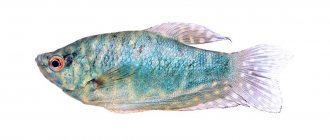As a rule, guppies give birth without problems. These fish reproduce frequently and quickly, without requiring special, difficult conditions. But sometimes the well-oiled mechanism malfunctions, and the pets stop breeding. Troubles also happen with pregnant females. To avoid problems or quickly resolve them, you need to know how mating and childbirth occur in fish. This is what our article is about.
General information, puberty
Guppies are viviparous; eggs grow inside the body. During the birth process, a fully formed individual is born, able to swim and independently obtain food. One female is capable of bearing offspring 7-8 times in her life, giving birth to up to 2 thousand babies. To get healthy fry, choose bright and large males for mating.
Full puberty in guppies ends at 3 months, but there are specimens that can become pregnant at 1 month. If breeding fish is planned in advance, then you need to prepare a special spawning ground where the necessary conditions for mating will be created. However, the fertilization process can also occur in an aquarium with other fish.
Swordtails
Female swordtails are ready to mate from the age of 8 months, because it is at this age that these fish end puberty. If a female swordtail is pregnant, a dark spot appears on her belly, and the belly itself takes on a rounded shape. Closer to childbirth, the tummy increases and takes on a square outline.
Pet mating conditions
A three-liter glass jar is suitable for equipping a spawning tank. Fresh, settled water is poured into it (temperature 23-27 degrees), stones are placed, and algae is planted. Then a male and a female are placed there. To speed up the process, the temperature of the aquarium water is raised by 4 degrees. You can determine the beginning of mating by how the males begin to chase the females.
The male fertilizes the fish using the genital organ - the gonopodium. The organ is formed only in individuals that have reached sexual maturity. The gonopodium has the shape of a fin with several tube-shaped processes.
If breeding takes place in an aquarium with other fish, then make sure that there are not a large number of males there. They can chase the poor fish to the point of exhaustion or even death. If you notice that one of the males is showing interest in the female, it is better to place the pair in another container. After mating, return the fish to the community aquarium, where the female will live until she gives birth.
We recommend reading
Aquarium fish parrots
Depositing - behavior before childbirth
The body changes. The abdomen protrudes from the sides, downwards. A distance in the form of a protrusion is formed between it and the head. The female is moved into a separate container of 3-5 liters. The bottom is covered with Java moss so that newborns can hide. If the process takes place in a common aquarium, follow 2 rules:
- lack of other fish species;
- the presence of greenery to shelter young animals.
Jigging is carried out shortly before birth, so that the female does not experience severe stress when changing her environment. Special soil is not placed on the bottom of the spawning tank. The water must be clean. For a general aquarium, purchase a special tray.
Determination of pregnancy in fish
An inexperienced aquarist may not recognize the expectant mother. We'll tell you how to understand that a female guppy is pregnant.
It is easy to establish this fact: sharp external and behavioral changes are observed. The fish develops a round abdomen, which becomes square before birth. Compared to the background of the abdomen, the female's head looks small. You can tell when labor is approaching by the appearance of a dark spot in the lower abdomen. The shiny black eyes of the fry are visible through the thin skin.
Changes also occur in behavior. Before giving birth, the guppy tends to move less and loses its appetite. Convulsions and vomiting rarely occur. A pregnant fish tries to stay close to the heater.
How to establish pregnancy
The expert will not only understand at first glance that the female is pregnant, but will also set a fairly accurate date. A beginner just has to learn this. First of all, pay attention to the external signs of the fish. Usually slender and even thin, it suddenly begins to “put on weight” - the abdomen becomes noticeably rounded, which is why the body loses its streamlined shape, the fish becomes slower and clumsier.
At the same time, a dark spot appears near the anus, which grows over time. A few days before birth, with good lighting and a good location of the fry, you can even see their eyes.
Pregnancy usually lasts 22-26 days. But in some cases this period increases to 35 or even 40 days - stress, unsuitable temperature or illness have an effect.
Now you know what a pregnant guppy looks like before giving birth, and you can take care of her. Once the spot is dark enough, you should be prepared for the fry to appear any day now.
Other signs and overfed fish
Groups of males always begin to chase the pregnant female and nuzzle her lower abdomen, so she tries to hide in a secluded dark place.
In the early stages, while there is no abdomen yet, the expectant mother is also distinguished by her behavior: she herself chases the males, moves more and eats abundantly.
Before labor begins, the female develops a swelling in the area of the cloaca. If it appears, remove the fish - labor will begin in 2-3 hours.
If the fish has simply eaten too much, its abdomen also becomes rounded, but if you look at the guppy from above, its sides are not round. The behavior of guppies before giving birth is unusual, but an overfed fish behaves as always.
Behavior before childbirth
From external signs - at some point the fish’s belly becomes rectangular. Loss of appetite is also a signal that the fish will give birth soon. Also, before giving birth, the guppy trembles and tries to hide in shelters or algae, preferring shaded places. If there is a heater in the aquarium, the fish will lie next to it or prefer to sit on the bottom.
When to Jigging
Before giving birth, the female guppy should be placed in another container to ensure her peace of mind and create conditions for the successful birth of offspring. Temporary relocation will also help protect the fry from being eaten by other fish species. There is no need to remove the fish if there are no signs of imminent labor. A change in habitat brings more stress to the expectant mother, for this reason the aquarist must ensure that the fish stays separately for as short a period of time as possible.
Optimal conditions for women in labor
Select the volume of the aquarium within 15-30 liters. If the size is smaller, it is more difficult to monitor water quality and temperature. But if the container size is too large, it is difficult to monitor and feed the fry.
Pour clean water, no soil is needed. For algae, tricchi, Java moss and any other aquatic plants are suitable. The main thing is that they are thick. In addition, it is necessary to install an internal filter with a large chamber. In order not to harm the fry, set the power to low, otherwise they will be injured by the flow of water. The filter is kept on around the clock.
To reduce the stress level in the female, you can not put her in a separate container, but buy a transparent tray that is attached to the glass of the aquarium.
Birth process and number of offspring
Females give birth 30-40 days after fertilization. The gestation period depends on the age of the fish and living conditions. The number of newborn fry is determined by the age of the female and the number of previous births. The first time guppies give birth to about 10 babies, in all subsequent times the number of newborns can reach 100-180. As a rule, 40-50 fry are born the second time, and 70-100 or more the third time. The larger the female, the more babies she produces.
We recommend reading
How long do betta fish live?
The duration of labor is from 2-3 to 24 hours. Guppies give birth at night or early in the morning. Before the process begins, the fish's tail trembles. Sometimes she freezes for a while. As soon as the birth begins, immediately catch the fry and transfer them to another jar.
How does childbirth occur?
Guppy labor begins at night or in the morning and lasts up to several days. Most often, childbirth occurs without complications. During the reproductive process, guppy fry are released in batches or individually at different time intervals. The fish's tail trembles violently, then freezes, and the babies appear. The behavior of the fry may vary: some of them will be full of energy, while others will be slow and inhibited. The difference is due to the fact that some newborns take time to gain strength.
End of labor and possible problems
Maternal instinct in guppies is poorly developed, and the mother can eat her children. If you don't want to put them away, put more rocks and seaweed in the jar so that the babies can hide. A day after the end of the birth, the female is returned to the aquarium.
The fry behave differently: some are immediately active, others lay down on the bottom to rest. This shouldn't scare you. They are healthy, but they need time to get stronger.
There are times when a pregnant female guppy should start giving birth, but does not. There are two options: either you made a mistake in the calculations, or the fish has health problems. There are two methods of inducing labor.
Raise the temperature in the aquarium by 2 degrees (but not sharply, gradually) and replace the water by 30%. Or place a young male with the female. Once labor begins, return it to the aquarium.
How to care for an expectant mother
Care is relatively simple and differs little from what a female guppy is accustomed to when living in a regular aquarium.
First of all, you need to especially carefully clean the water from food residues. A pregnant woman may lose her appetite, causing food to accumulate at the bottom, rot and spoil the water.
It is also advisable to provide the female with only live food - this promotes better development and health of the fry.
If there is no live food, then you should switch to protein-rich dry food. Daphnia is a good choice - cheap, accessible and nutritious.
Make sure there are no temperature changes, which can negatively affect the condition of both mother and offspring.
Knowing how to care for pregnant guppies can increase the survival rate of the fry, as well as maintain the health of the breeding female. Therefore, when breeding, you should not lose sight of this point.
Rules for caring for fry
The first 5 days of life are most important in the development of fry. They are provided with six meals a day. They give:
- special food for newborn fish;
- ciliates;
- rotifers;
- microworms.
From 2 to 8 weeks, the young are fed three times a day. Slowly transfer to food for adults, adding chopped bloodworms to the diet.
Boiled yolk is used as a vitamin supplement. Knead with a small amount of aquarium water and pour into a container with fry. This helps young individuals acquire a bright color.
Another important factor is adequate lighting. In the first week of life it should be around the clock.
We recommend reading
What fish can live without a filter and oxygen?
With proper nutrition and lighting, after 2 weeks the fry will grow to 2 cm in length. You can move them into an aquarium with adults.
Gender of babies and problems with reproduction
Gender characteristics appear 14 days after birth. Females at this age acquire a black spot in the lower part of the abdomen (next to the anal fin). But in some females the spot forms at 1.5 months.
Males gradually acquire color. The process stops when puberty is reached. Maturation depends on the thermal regime in the aquarium: the higher the temperature, the faster the young animals develop. The optimal temperature for growing fish is 22 degrees. Also, the warmer the water, the smaller the matured individuals will be.
Do not forget that fry grow differently. It is advisable to separate large and small individuals and keep them in different containers.
Guppies reproduce quickly and regularly. When optimal conditions are created, the fish breed once a month. If you think they are not giving birth, watch carefully. Most likely, the fry are born, but are immediately eaten by older individuals. To check this, place the fish in a separate container, where they will always be visible.
Share our article on social networks, because every aquarist should know about the peculiarities of guppy reproduction and the preservation of offspring. Tell us about your personal experience in the comments and don't forget to like.
Guppy
Pregnant guppy
These fish, like swordtails, are viviparous, and in order to bring new offspring they do not necessarily need the presence of a male; one mating is quite enough. It is very easy to determine pregnancy in female guppies by looking at the belly, it increases very much, and you will not miss it. A spot will also appear, which will become much larger by the time of childbirth. So the difference in determining pregnancy between guppies and swordtails is small, the only difference is that the guppy needs a male only once, but the swordtails need it every time.











